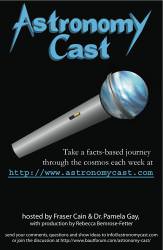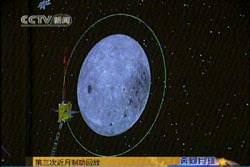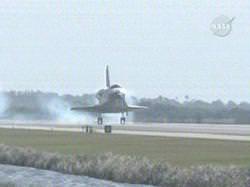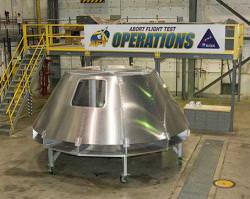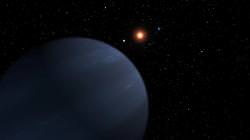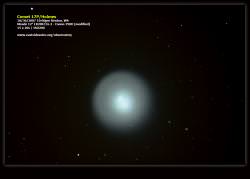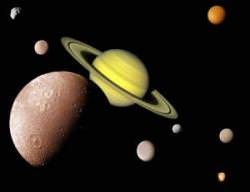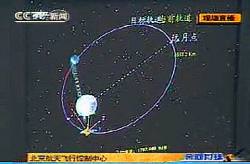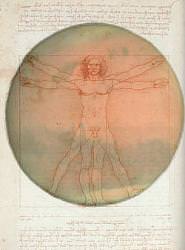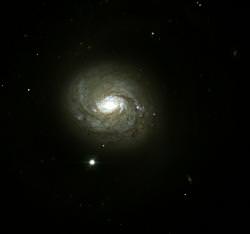Monday, November 5 – If you’re out looking for meteors this morning – and even if you’re not – take a look at the sweet pairing of the Moon and Venus. Take out a scope! Which has the larger crescent visible?
Today in 1906, a man named Fred Whipple was born. If that name doesn’t ring a bell for you – it should. Thanks to Dr. Whipple’s work we have a clearer understanding of the orbital mechanics of comets and their relation to meteoroid streams. Not only that, but he founded the SAO observatory in Arizona, discovered six comets, made invaluable contributions to research in the upper atmosphere, and was the first to call a comet a “dirty snowball.” His guess about the outgassing properties of comets was proved true when the first flyby of Comet Halley was made!
To honor Dr. Whipple a bit, let’s have a look at a beautiful optical pair/multiple system as we journey to the southernmost star in the “Circlet” – Kappa Piscium.
Easily split in even binoculars, this lovely green and violet combination of stars may have once belonged to the Pleiades group. 5th magnitude Kappa is a chromium star – one with unusual spectral iron properties – which rotates completely in around 48 hours. It shows lines of uranium, and the possibility of a very rare element known as holmium. Both the uranium and osmium content could be the result of a supernova explosion in a nearby star. Enjoy this colorful pair tonight!
Tuesday, November 6 – Tonight let’s head less than a degree south-southeast of Delta Ceti (RA 02 43 40.83 Dec -00 00 48.4) to have a look at a galaxy grouping that features the magnificent M77.
Discovered on October 29, 1780 by Pierre MÈchain, Messier cataloged it as #77 around six weeks later as a “nebulous cluster” – an accurate description for a small telescope. It wasn’t until 1850 when Lord Rosse uncovered its spiral nature that we began to view it as the grand structure seen in today’s modern telescopes.
Around 47 million light-years away, larger instruments will reveal its wide spiral arms where the older stars call home, and the concentrated core region where gigantic gas clouds move rapidly and new stars are being formed – a core which contains such a massive energy source that it emits spectrum of radio waves. After decades of study, the highly active nucleus of this Seyfert galaxy is known to have a mass equaling 10 million suns and a 5 light-year wide disc which rotates around it, which has intense star forming regions. This is one of the brightest known, and was cataloged by Arp as number 37 on his list of peculiar galaxies.
While even binoculars can spot the core, and modest scopes can reveal M77’s glory, larger telescopes will also spy 10th magnitude, edge-on NGC 1055 about half a degree north-northwest and 11th magnitude, face-on NGC 1073 about a degree north-northeast. Enjoy them tonight!
Wednesday, November 7 – Today in 1966, Lunar Orbiter 2 was launched. 30 years later on this same date, the Mars Global Surveyor left on its journey. Tonight let’s journey back to the area around M77 – because we’ve got more to explore!
Let’s start with Delta Ceti and head north about a degree for NGC 1032 (RA 02 39 23.74 Dec +01 05 37.7). Discovered in 1783 by Sir William Herschel and cataloged as H II.5, this 13th magnitude edge-on galaxy isn’t for the smaller scope, but that doesn’t mean it’s not interesting. Possessing a bright core region and an almost stellar nucleus, this superb galaxy was home to a supernova event in 2005!
Now, have a look at M77 again and head less than two degrees east for a pair of north/south oriented galaxies – NGC 1090 and NGC 1087 (RA 02 46 33.70 Dec -00 1 4 49.0). At around 120 million light-years away, northern NGC 1090 (H II.465) is also a supernova candidate, with events being reported in both 1962 and 1971. At close to magnitude 13, this barred spiral isn’t easy, but it can be spotted with aversion and a mid-sized telescope.
About 15′ south is NGC 1087. Although the pair seem quite close – no interaction between them has been detected. At magnitude 11, smaller scopes stand a much better chance a picking out 1087’s faint, round glow…while large scopes will get a sense of tightly wound spiral arms around Herschel II.466. Its barred structure is quite curious – far smaller than what is known to be common in this type of structure, but still a grand star forming region. A region that held a supernova event in 1995!
Check out this active group tonight…
Thursday, November 8 – Born on this day in 1656, the great Edmund Halley made his mark on history as he became best known for determining the orbital period of the comet which bears his name. English scientist Halley had many talents however, and in 1718 discovered that what were referred to as “fixed stars,” actually displayed proper motion! If it were not for Halley, Sir Isaac Newton may never have published his now famous work on the laws of gravity and motion. If Halley were alive today, you could bet that he’d have a big scope aimed about 4 degrees east of the Zeta and Chi pairing in Cetus to have a look at Hickson Compact Galaxy Group 16 (RA 02 09 31.71 Dec -10 08 59.7).
Consisting of four faint, small galaxies designated as NGC 835, NGC 833, NGC 838 and NGC 839 clustered around a 9th magnitude star, these aren’t for a small scope – but are a true challenge for a seasoned observer. Groups of galaxies such as Hickson 16 are believed to be some of the very oldest things in our Universe – and this particular one has a reputation of having an extremely large amount of starburst activity that is close enough for scientists to study. They were all cataloged by William Herschel in this month (on the 28th) in 1785. The northernmost, NGC 833, is known as HII.482, roughly magnitude 13, followed by NGC 835 (HII.483) which holds a magnitude 12. Next in line is NGC 838 (HII.484) at close to magnitude 13, followed southernmost by NGC 839 (HII.485) at magnitude 13. Not easy… But this beautiful crescent of four is worth the effort!
Friday, November 9 – Today is the birthdate of Carl Sagan. Born in 1934, Sagan was an American planetologist, exobiologist, popularizer of science and astronomy, and novelist. His influential work and enthusiasm inspired us all. If Carl were with us on this New Moon night, he would encourage amateurs of every level of astronomical ability! So let us embark to honor his memory with an optical pairing of stars known as Zeta and Chi Ceti, a little more than a fistwidth northeast of bright Beta. Now have a look with binoculars or small scopes because you’ll find that each has their own optical companion!
And northeast we continue with the largest of telescopes to investigate a galaxy cluster known as Abell 194 (RA 01 26 01.30 Dec -01 22 02.0). Over 100 galaxies have been found in this area and most of them are around 265 million light-years away. The brightest is NGC 547 and the pairing of NGC 547/545, which may be interacting with the elliptical NGC 541. Other viewable members include NGCs 548, 543, 535, 530, 519, 538, and 557, as well as far more southern 564, 560 and 558, just north of another optical double. No matter what you chose to look at tonight, as Dr. Sagan would say: “We are all star stuff.”
Saturday, November 10 – Tonight let’s have a look at one of the most elusive Messiers of all as we head about two fingerwidths northeast of Eta Pisces in search of M74 (RA 01 36.7 Dec +15 47).
Discovered at the end of September 1780 by MÈchain, M74 is a real challenge to smaller backyard telescopes – even at magnitude 9. This near perfect presentation of a face-on spiral galaxy has low surface brightness, and it takes really optimal conditions to spot much more than its central region. Located about 30 to 40 million light-years away, M74 is roughly the size as the Milky Way, yet contains no central bar. Its tightly wound spiral arms contain clusters of young blue stars and traces of nebulous star forming regions that can be seen in photos, yet little more than some vague concentrations in structure are all that can be noted visually even in a large scope. Yet, if sky conditions are great, even a small telescope can see details! Add the slightest bit of light pollution and even the biggest scopes will have problems locating it.
Don’t be disappointed if all you see is a bright nucleus surrounded by a small hazy glow – just try again another time. Who knows what might happen? A supernova was discovered in 2002 by a returning amateur and again in 2003 from the southern hemisphere. When it comes to M74, this is the very best time of year to try with a smaller scope!
Sunday, November 11 – Heads up! Tonight Antares will be within a half degree of the very young crescent Moon. For some observers, this could be an occultation, so be sure to check IOTA information.
A true observer was born on this day 1875. His name was Vesto Slipher, who spent some very quality time with the 60″ and 100″ telescopes on Mt. Wilson. Slipher was the first to photograph galaxy spectra and measure their redshifts, which led to the discovery of the expansion of the universe by Edwin Hubble.
On this night in 1572, the incomparable Tycho Brahe set out to record a bright new star. Today we realize he was looking at a supernova! “Visible” now as a supernova remnant only at very long wavelengths in the constellation of Cassiopeia, if you are good with your finderscope, you can still view it as a 7th magnitude star. Using Gamma, Alpha and Beta as your visual starting point, use binoculars to locate Kappa just north of this trio. Small Kappa will also be part of a configuration of stars which will look much like our starting point, only much dimmer. From Kappa, you will see a line of stars heading northwest. The very first in this series of 7th magnitude stars is SN 1572 (RA 00 25 08.07 Dec +64 09 55.7). According to Tycho’s report from Burnham’s Celestial Handbook:
“On the 11th day of November in the evening after sunset, I was contemplating the stars in a clear sky. I noticed that a new and unusual star, surpassing the other stars in brilliancy, was shining almost directly above my head; and since I had, from boyhood, known all the stars of the heavens perfectly, it was quite evident to me that there had never been any star in that place of the sky, even the smallest, to say nothing of a star so conspicuous and bright as this. I was so astonished of this sight that I was not ashamed to doubt the trustworthyness of my own eyes. But when I observed that others, on having the place pointed out to them, could see that there was really a star there, I had no further doubts. A miracle indeed, one that has never been previously seen before our time, in any age since the beginning of the world.”
So bright was the event, that it rivaled Jupiter at the time and soon surpassed Venus – being visible during the day for nearly two weeks. It had faded by the end of November, slowly changing color to red when it passed away from strong visibility almost 16 months later. We’ll be forever glad it wasn’t cloudy at the time, for the event inspired Tycho Brahe to dedicate his life to astronomy… And who’d blame him?!

